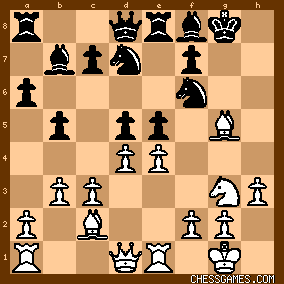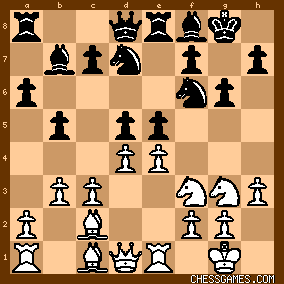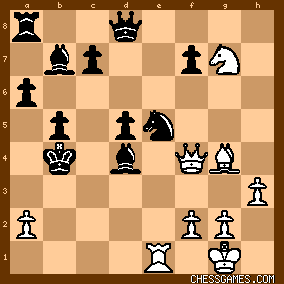| Nov-06-06 | | outplayer: 15...d5 16.Bg5 Shirov improved on Polgar's play in Essent but his moves only led to a draw. Is it the end of this line? |
|
| Nov-06-06 | | Resignation Trap: <outplayer> Yes, this was the same line as Judit Polgar vs Mamedyarov, 2006 , and Shirov followed the suggested improvement. Unless something more forceful (or more risky) is found, I'd say that it is the end of the line. |
|
| Nov-06-06 | | bernardchinshin: What happens if 20...Nxe5? |
|
| Nov-06-06 | | aw1988: I think 20...Nxe5 21. cxd4 Ned7 22. Bf5 |
|
| Nov-07-06 | | ahmadov: <Resignation Trap: <outplayer> Yes, this was the same line as Judit Polgar vs Mamedyarov, 2006 , and Shirov followed the suggested improvement.> When Polgar played that game she just intended to get 0.5 to win the tournament. Does your comment mean that Shirov followed the suggested improvement to draw the game? In other words, did Shirov played this opening with an aim to get 0.5 points? Is he becoming a player who wishes to get points only playing for draws? |
|
| Nov-07-06 | | Atking: <bernardchinshin: What happens if 20...Nxe5? aw1988: I think 20...Nxe5 21. cxd4 Ned7 22. Bf5> Or 22.Qd3 Qc8 (22. ...Bg7 23.Nh5!) 23.BxNf6 NxBf6 27.Nh5 Bg7 28.NxBg7 KxNg7 29.Qg3+ Kf8 30.Qh4 Ne4 31.f3 wins |
|
| Nov-07-06 | | acirce: Why isn't <notyetagm> and the rest of the pack here to blast the players for this cowardly draw? Should I expect a reply along the lines of "This game wasn't boring, didn't you see Shirov's amazing Tal-like piece sac OMG he is a genius unlike the boring Drawko"? |
|
| Nov-07-06 | | alicefujimori: <ahmadov><When Polgar played that game she just intended to get 0.5 to win the tournament.>This is obviously not true. Polgar played for a win in that game with 23.Nf5 and went on to lose. 23.Nh5 is theory and was played before the Polgar game and this game. <acirce>That's probably because Shirov doesn't do this often. Obviously, Shirov had his reasons to be happy with a draw in this game. Warm up, perhaps? Anyway, this is only round 1 so let wait and see what happens before getting emotional about the words "drawing" and "boring" again. :) |
|
| Nov-07-06 | | ahmadov: <alicefujimori> How do you know that Nf5 was played for a win? That was just a blunder by Polgar. Many people stated this even on this web site while the game was relayed live. |
|
| Nov-07-06 | | alicefujimori: <ahmadov><How do you know that Nf5 was played for a win? That was just a blunder by Polgar.>I doubt that was a delibrate blunder by Judit because 23.Nh5 was known theory and one would be a fool to assume that Judit does not know about 23.Nh5 as she had already entered into this variation before in her game against Spassky in 1993. So the question is, why would Judit tried to improve with another move when she knew already that 23.Nh5 could have led to a probable draw, especially when you claim that she was playing for a draw? The answer is obviously, she wasn't playing for a draw. She tried to improve on previous games (you only do that when you want to win, especialy when there was another move that was known to lead to a probable draw) but it didn't work out and it backfired on her. |
|
| Nov-07-06 | | MyriadChoices: Why not 32. Ne4+ |
|
| Nov-07-06 | | suenteus po 147: <acirce> Because, unlike Kramnik or Leko, Shirov has no fans and therefore cannot do any damage to world chess with his games :) |
|
| Nov-07-06 | | Resignation Trap: Here is a photo of this game in progress: http://www.russiachess.org/eng/imag... According to the official website, the players reached move 28 after only five minutes of play. |
|
Nov-07-06
 | | WannaBe: I'll bet they spent 4 minutes and 30 seconds of that time writing down the moves. |
|
| Nov-07-06 | | Resignation Trap: It doesn't surprise me that Shirov went in for this sacrificial line. He also has enjoyed the Perenyi Attack as in the game Shirov vs Judit Polgar, 1996 . Judit Polgar later took up this line herself, for example: Judit Polgar vs Svidler, 1998 . I believe that anybody who wants to improve upon his playing skills, a study of the tabiya (after 19.Bxg5) :

click for larger view with or without players of the silicon persuasion, would be beneficial. |
|
| Nov-09-06 | | ahmadov: <WannaBe: I'll bet they spent 4 minutes and 30 seconds of that time writing down the moves.> LOL (of course, after reading the previous post to which this one concerns) |
|
| Nov-13-06 | | gauer: Resignation Trap: how should each side aim to sac a piece here, or decide where to place the pieces or pawns?

click for larger view
Theory I keep reading about says that the major theme is (1) sliding the Q-pawns up a rank (as per Chigorin), (2) going for a Marshall (or sometimes Tarrasch Open) pawn chain with (a,c6, b,d5) and open K-file, (3) exchanging at d4 to get a semi-open Q-file vs counter-playwith the c5 break (4) taking on on the K-line to open the Q-line, (5) opening the Q-flank files with a4, (6) holding back with d3 instead of d(4(->5)), playing a Spanish Italian game. The diagram seems to tend to want to take too many pawns off too quickly (at least, for my liking), and so in this strategy, which P-structure is each side aiming for, and where is best to place the pieces to hold the tension. |
|
| Nov-13-06 | | Ezzy: An excellent analysis on this line by Lubomir Kavalek in the Washington post. http://www.washingtonpost.com/wp-dy... |
|
| Nov-13-06 | | percyblakeney: <Ezzy> Navara's analysis is very interesting. Shirov took a long think trying to find something better than a draw but didn't see Navara's suggestion <29.Ng7+ Kd7 30.Bf5+ Ke7 31.Qf4>. It could have continued with for example <31. ... Kd6 32. Bg4 Kc5 33. b4+ Kxb4> and white can choose between taking the knight or the bishop in this exciting position where black will have some problems to solve:
click for larger view |
|





































